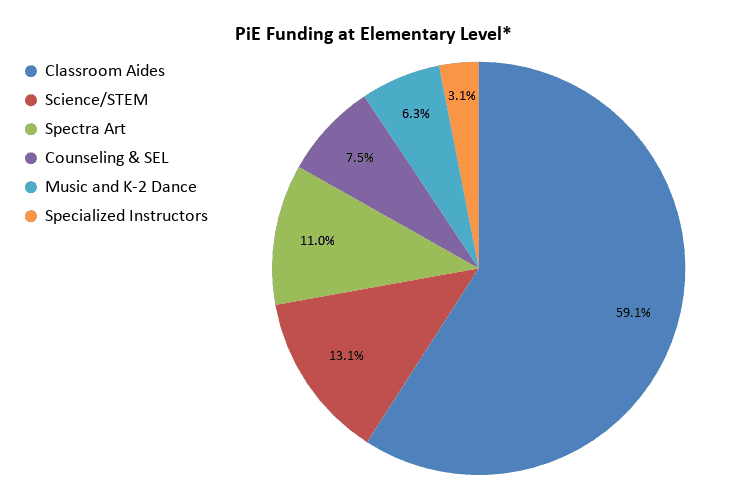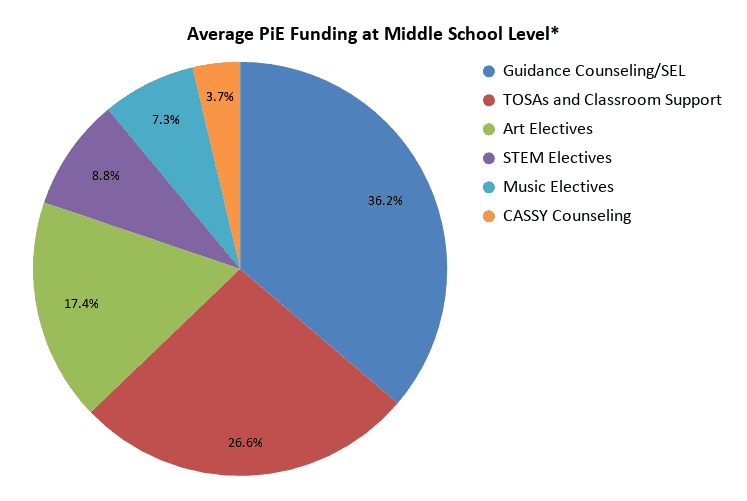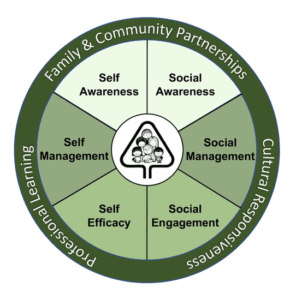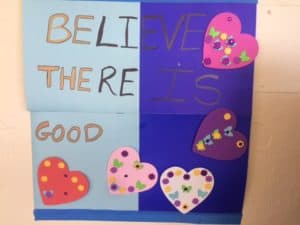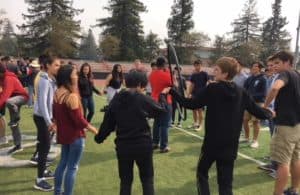The Slice – Winter 2019

From Donation to Disbursement
Perhaps you know that PiE funds support staffing in the arts, STEM (science, technology, engineering and mathematics), and wellness and support. Perhaps you have heard from teachers thanking you for making music education, tech and science electives, and Spectra Art possible with your donations. But how, exactly, does the magic happen? After you hit that “Donate” button, or send off your check, where does the money go and how is it managed?
The PiE fundraising campaign hits full-force in the fall, with back-to-school efforts and PiE rally days taking center stage. Donations continue to roll in from donors and their employers through the winter months. In the spring, the PiE board, made up of parent volunteers, assesses the results of the campaign, and votes to approve the amount of the final gift, divided into a large contribution that goes directly to the schools and a much smaller designation for Innovation Grants. At the beginning of the school year, funds are disbursed to each school, on a per-pupil basis based on enrollment data for that school year.
Learn more:
PiE Innovation Grants
Primary to PiE’s mission and vision is the promise to benefit each and every student in the district, at all levels of education.
In elementary school, principals allocate PiE funds to help pay for classroom aides, music and science instruction, and wellness support. Implementation of PiE funded programs and staff at each school varies, as different schools make choices to meet their specific needs. Spectra Art staff are funded centrally for all schools, ensuring that every student has access to a full art curriculum from Kindergarten through 5th grade.
“Every time I walk into a classroom and see an instructional aide providing personalized support, either by leading a small group of students, or by being another caring adult answering a child’s questions, I am grateful for Partners in Education.”
Marcela Simões de Carvalho, Escondido Principal
PiE provides essential funding for classroom aides at the elementary level, when having that extra caring adult in the classroom makes a huge difference in the education and well-being of K-5 students. Having an aide available means the teacher can spend more time on instruction and student interaction, while making sure that each and every student has a caring adult on hand for additional support. Providing more hands in the classroom is essential to student well-being and educational excellence.
PiE also supports staffing for science programs, like the Junior Museum and Zoo visits, Spectra Art instruction, music and dance programs for all grade levels, and counseling support.
See the breakdown for your child’s school:
- Addison
- Barron Park
- Juana Briones
- Duveneck
- El Carmelo
- Escondido
- Fairmeadow
- Hoover
- Nixon
- Ohlone
- Palo Verde
- Walter Hayes
In middle school, principals build the PiE funds into their budgets, once again making sure that the money is used to support the arts, STEM, and wellness and support.
“PiE … continues to allow support for our diverse elective offering, ability to provide grade level guidance counseling, technology resources, and increase our ability to foster social-emotional development in our students.”
Melissa Howell, Fletcher Middle School Principal
In the critical middle school years, PiE funds allow for a complete network of support, from class counselors, assistant principals, and CASSY counseling. Specialized SEL programming, such as Challenge Day at Greene and the Mix It Up Lunch at JLS, also keeps students connected and supported.
By funding a variety of electives, PiE makes it possible for students to explore a wide range of interests. A robust offering, with a large number of class options, also results in a smaller class size for all electives, even if they aren’t directly funded by PiE (not all electives fall within the designated PiE funding categories).
See the breakdowns for:
At Paly and Gunn, PiE contributions, allocated by the principals according to PiE guidelines, fund critical staffing in counseling, classroom support, and expand the range of electives.
“PiE funding allows us to better meet the academic and social/emotional needs of all our students. We’re able to offer innovative classes that foster the 21st century skills–collaboration, communication, critical thinking and creativity–that our students need beyond their high school years.”
Adam Paulson, Paly Principal
PiE funding supports an extensive student support program of counseling and SEL learning, to help them set and achieve academic and personal goals, manage stress, and prepare them for the world outside of school. Education excellence means educating the whole child—and preparing them to participate in society after they graduate.
See the breakdowns for:
Oversight and Priorities
PiE reviews the use of funds annually with the school principals to ensure appropriate use of funds and alignment with donor priorities. Feedback collected in the annual donor survey informs those priority designations. The PiE board, made up of PiE parents and donors, just like you, spends hours creating the survey, collecting donor feedback, and analysing the results every year. The results become the source material for our strategic planning for future campaigns. Keep an eye out for the survey next spring, and be sure to share your thoughts and priorities.
To learn more about how PiE works, see the PiE FAQs.
Counseling and Beyond: Growing into Social Emotional Learning (SEL)
Social-emotional learning—we hear about it all the time, but what, actually, does it mean? Our students may find mindfulness, stress management, self reflection, and conflict resolution a natural part of school, but to most of us parents, the idea that these are topics that can and should be taught in school is still new, and somewhat unfamiliar territory.
So let’s start by looking at a basic understanding of the components. SEL promotes core competency in the following areas:
- Self-management – these are the “executive function” skills of goal setting, stress management, impulse control, and self discipline
- Self awareness – Self perceptions and confidence, identifying emotions
- Social awareness – Empathy, respect, appreciating diversity and other perspectives
- Relationship skills – Communication, teamwork, and relationship building
- Responsible decision-making – Evaluating situations, problem-solving, and ethical considerations
Problem solving and conflict resolution, identifying and managing emotions, working with others are all key not just to well being, but also to long term success, as a Robert Wood Johnson Foundation study found. These are learned skills that can be taught and expanded through a well-considered curriculum, such as School-Connect, selected by PAUSD.
(See CASEL’s website, https://casel.org/, for more information)
Read the study:
How Children’s Social Competence Impacts Their Well-Being in Adulthood
Learn about School-Connect:
Social-Emotional and Academic Skills Curriculum
Palo Alto schools continue to build on success in elementary and middle schools, and share learning with each other as they evaluate and improve their SEL programs.
“Academics are just one sliver of the skill sets that children need to be taught. All the signs point to the whole child approach fostering self awareness, self advocacy, self regulation, and resilience first and foremost.”
Jessica Resmini, Parent, Ohlone Elementary and Greene Middle School
At Gunn, the SELF (Social and Emotional Literacy and Functionality) program is now in its third year. Students, grouped in cohorts, work with each other and with teacher-mentors to build trusting relationships and develop empathy, resilience, and other core social-emotional skills. The program has been shown to improve connection between teachers and students on campus.
“The ultimate outcome is more resilient, more motivated, more compassionate, and more self-aware individuals capable of weathering the ups and downs of life, career and civic discourse.”
Courtney Carlomagno, Gunn High School SEL TOSA
Learn more about:
Gunn High School SELF Program
At Paly, teacher advisors work with students each week, using the above School-Connect curriculum. Students engage with each other and their advisors to boost their emotional wellness, social management, and academic skills. Students receive further counseling and social-emotional coaching from their class guidance counselors, on an as-needed basis, as they encounter both academic and personal hurdles in their high school years.
Including social-emotional learning at all levels of education results in perseverance in efforts, engagement with classwork, cooperation with others to achieve a goal together, and managing relationships with teachers and peers.
CASEL’s report, including a write-up of PAUSD:
SEL Trends: All Schools Benefit (CASEL)
Learn about PAUSD middle and high school comprehensive approach to counseling:
Counseling Logic Model
Thank You for Supporting PiE
* Data used in this newsletter reflects 2018-19 funding, as full budgets from 2019-20 are not yet available. Funding levels for the current year are not expected to change significantly from those represented here.
